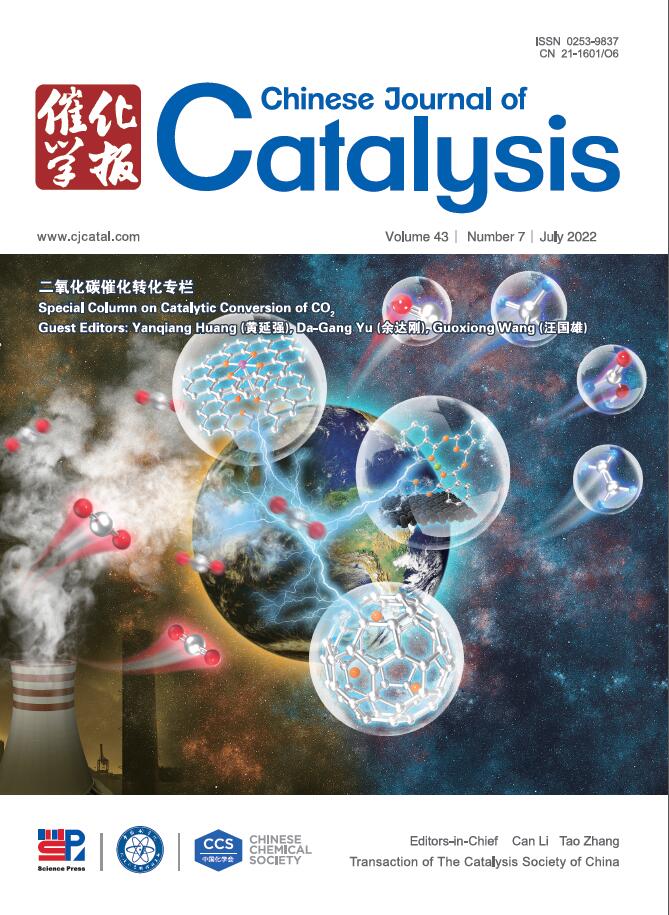用于环境监测和能源转换的 CeO2 衍生纳米复合光催化剂的化学性质
IF 15.7
1区 化学
Q1 CHEMISTRY, APPLIED
引用次数: 0
摘要
光催化具有可行性、经济性和环境安全性,是能源转化和环境利用的重要过程。由于其纳米复合材料具有光学活性、宽带隙(Eg)、可逆价态(Ce3+/4+)、丰富的缺陷结构、高氧存储能力、离子电导率和优异的耐化学性等独特的特性,CeO2的配位化学得到了极大的关注。系统总结了合成方法、颗粒形态和晶体结构对提高ceo2衍生杂化异质结(HHJ)光催化剂效能的重要性。选择合适的合成方法和复合材料的形貌有利于抑制电子-空穴(e−-h+)的快速复合,改善可见光吸附,并大量生成e−-h+对以加速光催化剂的活性。各种改性方法包括元素掺杂(金属/非金属掺杂)、异质结构建(低/宽Eg半导体(SCD)、碳、导电聚合物材料)、缺陷工程和多组分杂化复合材料。这些方法有助于合理设计有效的ceo2基复合光催化剂,促进可持续发展,因为随着e−-h+对光生的增加,氧的迁移率增强,电荷转移迅速,最大的可见光俘获和减慢电荷重组速率。还研究了CeO2共轭杂化复合材料在废水(抗生素/有机染料/化学/制药)的光氧化、重金属去除、H2生产、CO2还原和H2O裂解应用中的进展。随后,分析了几种异质结光催化剂在ceo2基复合材料中遇到的困难和基本思想,并提出了未来的发展方向。本文章由计算机程序翻译,如有差异,请以英文原文为准。
Chemistry of CeO2-derived nanocomposites photocatalysts for environment monitoring and energy conversion
Photocatalysis is an important process in energy conversion and environmental usage because of its feasible, profitable, and environmentally safe benefits. Coordination chemistry of the CeO2 is gaining significant interest because its nanocomposites show unique characteristics namely optically active, wide bandgap (Eg), reversible valence states (Ce3+/4+), rich defect architectures, high O2 storage capability, ionic conductivity, and exceptional chemical resistance. Systematically summarized the importance of synthesis methods, particle morphology, and crystal structure aiming at how to heighten the efficacy of CeO2-derived hybrid heterojunction (HHJ) photocatalyst. Selection of an appropriate synthesis method and morphology of the composite materials are beneficial in inhibiting the rapid electron-hole (e−-h+) recombination, improvement in visible light adsorption, and large generation of e−-h+ pairs to accelerate the photocatalysts activities. Various modification approaches include elemental doping (metal/non-metal doping), heterojunction construction (lower/wide Eg semiconductors (SCD), carbon, conducting polymeric materials), imperfection engineering, and multicomponent hybrid composites. These methods assist as a valuable resource for the rational design of effective CeO2-based composite photocatalysts for sustainable development owing to the enhancement of oxygen species mobility, rapid charge transfer, maximum visible light captivation and slow down the charge recombination rate with increase photogeneration of e−-h+ pairs. Also examines the advancements made in CeO2 conjugated hybrid composites in photo-oxidation of wastewater effluents (antibiotic/organic dyes/chemical/pharmaceutical), heavy metal removal, H2 production, CO2 reduction, and H2O splitting applications. Subsequently, the difficulties and fundamental ideas behind several heterojunction photocatalysts encountered by CeO2-based composites are examined, and future directions for their development are suggested.
求助全文
通过发布文献求助,成功后即可免费获取论文全文。
去求助
来源期刊

Chinese Journal of Catalysis
工程技术-工程:化工
CiteScore
25.80
自引率
10.30%
发文量
235
审稿时长
1.2 months
期刊介绍:
The journal covers a broad scope, encompassing new trends in catalysis for applications in energy production, environmental protection, and the preparation of materials, petroleum chemicals, and fine chemicals. It explores the scientific foundation for preparing and activating catalysts of commercial interest, emphasizing representative models.The focus includes spectroscopic methods for structural characterization, especially in situ techniques, as well as new theoretical methods with practical impact in catalysis and catalytic reactions.The journal delves into the relationship between homogeneous and heterogeneous catalysis and includes theoretical studies on the structure and reactivity of catalysts.Additionally, contributions on photocatalysis, biocatalysis, surface science, and catalysis-related chemical kinetics are welcomed.
 求助内容:
求助内容: 应助结果提醒方式:
应助结果提醒方式:


